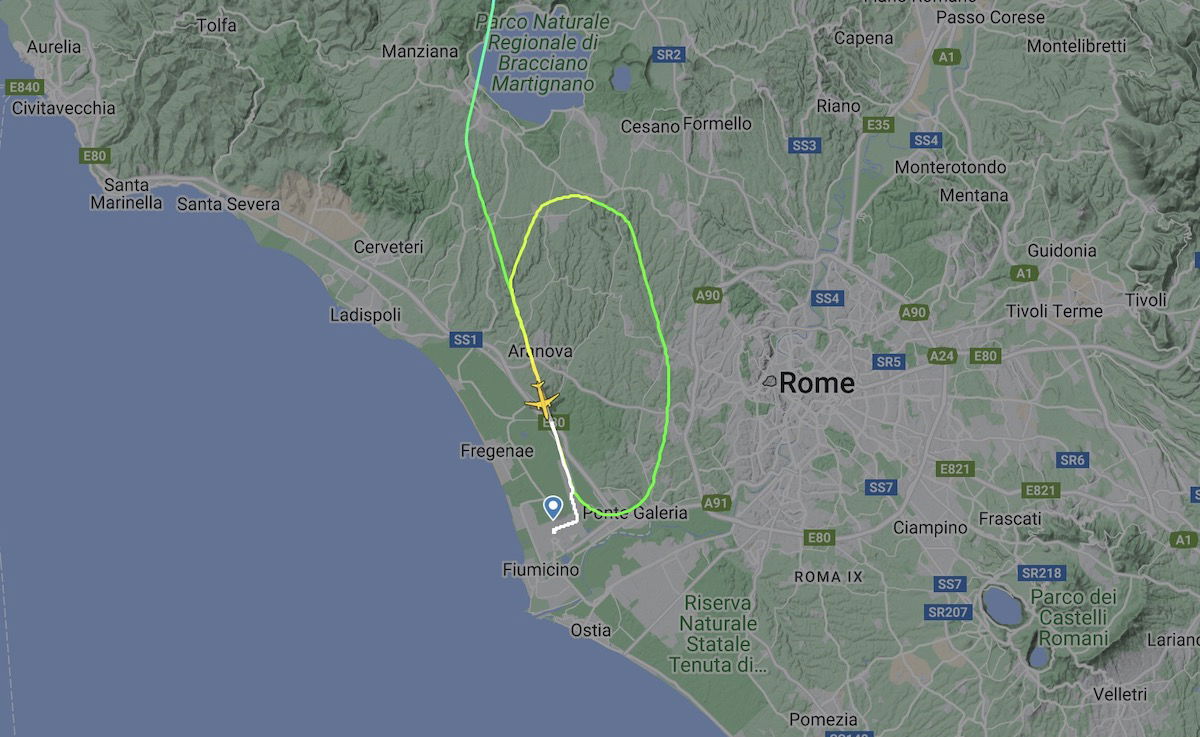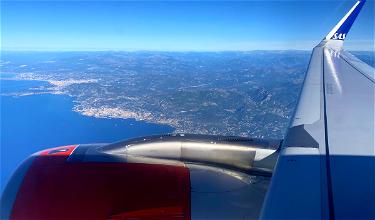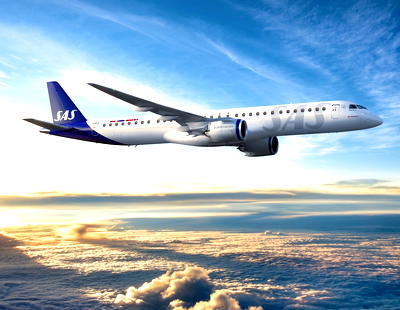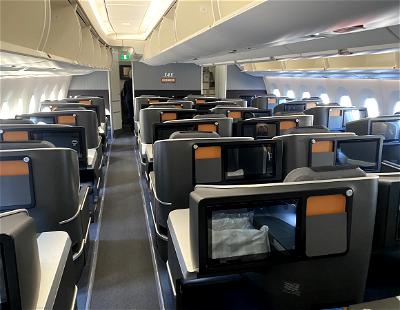File this one under “huh?!?”
In this post:
A320neo tries to land at 230 knots without flaps
The Aviation Herald reports on an incident that happened on February 13, 2023. This incident involves Scandinavian Airlines flight SK681 flying from Copenhagen (CPH) to Rome (FCO). The flight was operated by a roughly five year old Airbus A320neo with the registration code EI-SIC.
The 955-mile flight was totally routine, until it was descending for its approach toward runway 16L at Rome’s Fiumicino Airport. The plane descended down to 200 feet above ground level with its gear extended, flaps and slats still retracted, at a speed of 230 knots. 

Just to be clear, an A320neo’s typical landing speed is 130-140 knots, so the plane was going around 100 knots too fast.
The plane reached an altitude as low as 150 feet before performing a go around. At that point the aircraft climbed to 3,000 feet, and positioned for another approach. Around 10 minutes later, the aircraft landed safely on runway 16L with the flaps, slats, and gear extended
According to the METAR, weather at the time of the approach was quite good. There were no clouds, winds were only five knots, and there was six miles visibility. Furthermore, the pilots didn’t report any issues with the aircraft to air traffic controllers.
Can anyone make sense of this?
We’ve seen a lot of concerning aviation safety incidents lately. However, this one is unique for how darn strange it is:
- Why would the pilots continue the approach if they’re around 100 knots above the typical landing speed, since that’s not a speed at which you’d attempt to land (short of ditching in a life or death emergency)?
- How could the pilots forget the flaps? Presumably the Mode 4B “too low, flaps” alarm started going off right around the time the go around was being initiated?
Does anyone want to take a stab at how something like this could even happen? I can kind of see how a lot of the recent incidents could happen, as they may have involved being disoriented, or poor split second decisions. But flight data shows that the entire final approach was being performed way too fast, so why would neither pilot call a go around higher up than a couple of hundred feet?
Bottom line
Continuing the strange series of aviation incidents we’ve seen, an SAS A320neo was within a couple hundred feet of landing in Rome while flying at 230 knots without flaps extended. The aircraft ended up performing a last second go around, and landed safety after a second attempt several minutes later.
Anyone want to take a stab at explaining this situation?





managing aircraft energy is not as simple as slowing down with a car, a lot of factors can impact wether an approach is stabilised or not, such as with ATC shortcuts, weather, etc, which is quite common in Rome.
Flight radar and www.avherald.com are not official and verified sources. Indicated altitude on FR is not adjusted to actual barometric pressure at the airport. In this case - a high pressure situation which add altitude - reported QNH was 1036 which give approximately another 690 ft to the approach. According most SOP’s an approach shall be discontinued att 1000 ft above ground if not stabilized. It looks to me that this is the case. A...
Flight radar and www.avherald.com are not official and verified sources. Indicated altitude on FR is not adjusted to actual barometric pressure at the airport. In this case - a high pressure situation which add altitude - reported QNH was 1036 which give approximately another 690 ft to the approach. According most SOP’s an approach shall be discontinued att 1000 ft above ground if not stabilized. It looks to me that this is the case. A go-around performed at 1000 ft require some feet height loss until a climb is established. Runway changes occurs sometimes and not always early enough to be able to configure the aircraft to fulfil the stabilized approach criteria. We have all flown to Rome, haven’t we? Enjoy the weekend.
Likely a mechanical issue with the flaps. There can be a loss of flight control I f the flaps are deployed asymmetrically. This issue actually happened to me once as a pax on an Alaska Airlines 737: The flaps on one side wouldn’t deploy fully, so the plane landed with them partially retracted, resulting in a higher than normal speed. It caused the ARFF crew to standby and I’m sure it wasn’t fun for the pilots.
https://tomgorski.com/asr/737/Trailing_Edge_Flap_Assymmetry.pdf
Something here doesn't click: FCO is not a desert airport served by 1 flight a day: There is a traffic flow with several machines at various stages of approach, like boats following a river behind one another.
Any plane flying 100 miles too fast will trigger alarms and air control questions way before the plane itself detects a landing anomaly and shouts "Flaps": This info, if it is not completely erroneous, is AT LEAST extremely...
Something here doesn't click: FCO is not a desert airport served by 1 flight a day: There is a traffic flow with several machines at various stages of approach, like boats following a river behind one another.
Any plane flying 100 miles too fast will trigger alarms and air control questions way before the plane itself detects a landing anomaly and shouts "Flaps": This info, if it is not completely erroneous, is AT LEAST extremely incomplete.
Most approaches impose a set approach speed or at least "Over x and under y knots". This is so true that in the days of the Aeroflot Ilyushin 86 landing at JFK (1990's), the pilot in command had to turn left and right every few seconds as if he were drunk, in order to increase the distance between himself and the machine immediately ahead. The IL 86 could not fly slowly enough to maintain the distance in the queue.
It’s hilarious how all the sanctimonious lockdown trolls that wanted to tell everyone how to live their lives for 2+ years are now SHOCKED that people are out of practice at their jobs. The horrible effects of these insane lockdowns will take years to unwind.
What’s hilarious is that someone who knows less about public health than he does about aviation is trying to connect dots that don’t exist. Stick to QAnon, bud.
Might just be me.
Whilst I enjoy your reviews, these posts with safety near misses may not help, cause all we end up doing is speculating.
Speculating doesn't help in a safety incident. I'm sure NTSB will investigate if appropriate, and come up with the report.
Why would the NTSB investigate an intra-Schengen flight?
What jurisdiction does NTSB have over this flight?
Danish Traffikstyrelsen will look into this incident.
We can always speculate, no need to put a cover on things like this
This behaviour is unacceptable from a professional pilot of a commercial airline. Strict disciplinary action needs to be taken against the pilots involved.
I've had "hot approaches" before with wings clean and gear up until about 90 seconds before touchdown; typically due to outrunning an incoming thunderstorm or ATC spacing. The gear can be deployed at higher speeds than the flaps and can slow the aircraft down quite quickly - as long as you are decelerating at the outer marker and maintaining a stabilized approach, it should not be a problem. Clearly the crew here took it a...
I've had "hot approaches" before with wings clean and gear up until about 90 seconds before touchdown; typically due to outrunning an incoming thunderstorm or ATC spacing. The gear can be deployed at higher speeds than the flaps and can slow the aircraft down quite quickly - as long as you are decelerating at the outer marker and maintaining a stabilized approach, it should not be a problem. Clearly the crew here took it a bit too fast and made the right call to execute a go-around. Really a non-story.
I've posted the same comment in another of the related posts about a recent near miss, but I think it's a fair question/comment - are there in fact more near misses recently or are we simply hearing more about incidents now? Would love to see data supporting one way or another.
Someone posted a comment on another blog saying that all of these 'near" misses show how many safeguards there are in place. Admittedly...
I've posted the same comment in another of the related posts about a recent near miss, but I think it's a fair question/comment - are there in fact more near misses recently or are we simply hearing more about incidents now? Would love to see data supporting one way or another.
Someone posted a comment on another blog saying that all of these 'near" misses show how many safeguards there are in place. Admittedly this is not a good example, and seems like clear pilot error, but I do think there is truth to that.
This was obviously supposed to be on the JetBlue blog. Closed it, reopened a while later and didn't realize it was on this blog...
Several years ago I was on an American Airlines 757 bound for LAX. There was a malfunction of the flaps, and the pilot announced since they wouldn't extend that we would approach and land at a much higher speed than normal. We dumped fuel over the ocean and landed without incident but used most of the runway to come to a stop.
Pilot error.
This kind of issue had happened before (with disastrous results), and it’ll happen again.
“ File this one under “huh?!?””
I’m filing this one under “clickbait”!
Successful clickbait, in my case.
@ Never In Doubt -- Sorry, but how is this clickbait? The title of the post isn't "You'll Never Believe What Happened When An SAS A320neo Tried To Land In Rome." Rather the the title quite succinctly sums up what happened.
(Sorry for this long comment everyone else)
@ Never In Doubt So the title is "An SAS A320neo’s Bizarrely Hot Approach To Rome". I assume you are taking issue with the use of the words "bizarrely hot", because without it, the title would simply be "An SAS A320neo’s Approach To Rome" which, while an accurate description, would make no distinction with any other SAS A320neo's approach to Rome. So some sort of adjective/adverb will need...
(Sorry for this long comment everyone else)
@ Never In Doubt So the title is "An SAS A320neo’s Bizarrely Hot Approach To Rome". I assume you are taking issue with the use of the words "bizarrely hot", because without it, the title would simply be "An SAS A320neo’s Approach To Rome" which, while an accurate description, would make no distinction with any other SAS A320neo's approach to Rome. So some sort of adjective/adverb will need to be used to differentiate this particular approach from any other approach, from a purely editorial perspective.
While "bizarrely hot" may appear perhaps a little sensational, this very much depends on how English is used in your particular part of the world and I would venture to contend that it does not reach the level of "clickbait". Whilst I personally would not use "hot" (which I typically save for describing temperature), its use in describing speedy is not unknown (e.g. "hot wheels", hot on someone's tail). The word "bizarre" is also not a word I would typically use, and I would perhaps use "strange" to mean anomalous. So would "An SAS A320neo’s Strangely Speedy Approach To Rome" be better? Or even "An SAS A320neo’s Anomalously Rapid Approach To Rome"? Maybe you would classify them as clickbait too?
Perhaps to turn your comment into a constructive one, so that everyone may benefit greatly from your point of view, why don't you let us know what adverbs/adjectives you would use and why it would not be seen as clickbait?
@TC - Hadn't really considered whether the usage of idiom would render something 'clickbaity' or not. Interesting to consider. The term 'hot' in regards to speed is pretty common, at least in American English (not sure of other country's usage of English). For example, 'coming in hot' means you're coming in fast, potentially somewhat recklessly.
His English locution is not the best plus given to exaggeration characteristic of his countrymen